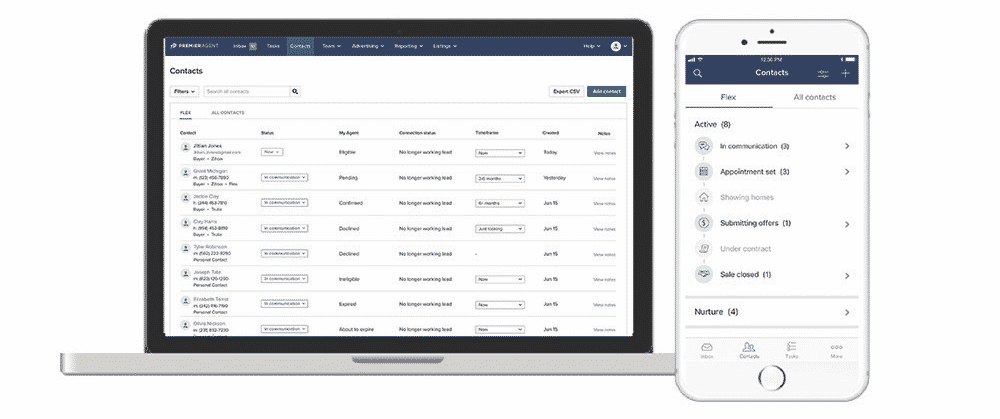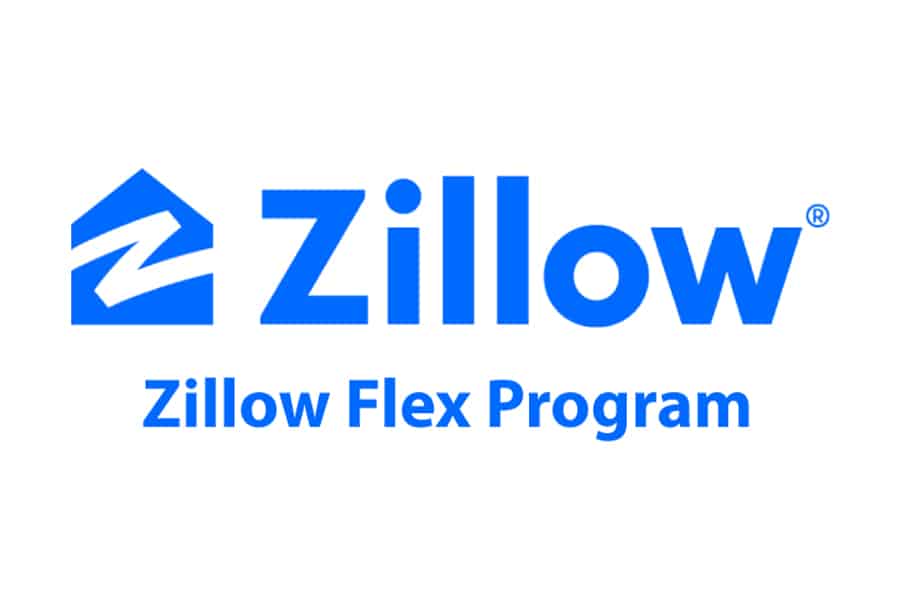Real estate lead generation has come a long way in the last 20 years. Gone are the days of hit-and-miss newspaper ads, untrackable radio spots, and placement in local magazines for which there was no clear return. With online real estate leads, we can track exactly where our leads come from, how many we get, and how much they cost, down to the penny.
But this last part—cost—is where a lot of agents (especially new agents) get tripped up. Lead generation can be expensive, and even though there is the clear incentive of a big payday when your deals close, some agents don’t have the budget to invest in lead generation upfront.
That’s where a program like Zillow Flex comes in. Zillow Flex is a new option from Zillow Premier Agent that allows real estate agents access to Zillow-generated leads at no upfront cost. If a lead turns into a client and closes a sale, then—and only then—do you pay Zillow.
The catch? Instead of paying an upfront cost for your lead, you pay a percentage of your commission, upward of 35%. Is it worth it? Every agent’s business is different, so in this article, we’ll give you all the information you need to determine that for yourself.
What Is Zillow Flex?

Zillow Flex is a payment option for Zillow Premier Agents, Teams, and Brokers that allows them to receive Zillow leads without paying any upfront cost. Using Zillow Flex, real estate agents only pay Zillow after a transaction successfully closes. Participating agents report Zillow Flex costing anywhere from 25% to 40% of the gross commission.
Zillow Flex is not the first program to offer this referral-style lead generation option. Companies like OpCity (now a Realtor.com asset), HomeLight, and Agent Pronto have been operating for a number of years, but the major difference between these options and Zillow Flex is that Zillow has unprecedented traffic and user trust.
Agent Pronto boasts on their homepage that “over 200,000 homebuyers and sellers have trusted Agent Pronto to introduce them to an amazing agent,” which is not bad for the lifetime of a business, except when you consider that Zillow’s monthly traffic exceeds 36 million visitors, generating them thousands of leads every month.
Their command of the space is overwhelming compared to their competitors; the available pool of leads for Zillow is orders of magnitude bigger than these three other options combined.
Where Is Zillow Flex Available?

According to Zillow’s website, Zillow Flex is only available in the following select markets:
- Fort Collins, CO
- Pueblo, CO
- New Haven, CT
- Norwich, CT
- Phoenix, AZ
- Atlanta, GA
Though this seems like a small selection, Zillow typically rolls new features out to select markets before rolling them out on a large scale, so you can likely expect to see Zillow Flex in most major markets by the end of 2021.
We’ve had reports from brokerages in the Buffalo, NY, area being offered the option to enroll in Zillow Flex in November 2020, so it’s clear that this option is expanding to a wider audience.
Who Is Eligible for Zillow Flex?

In order to qualify for Zillow Flex, you must meet the following criteria:
- Be a current Zillow Premier Agent in a participating market
- Have written permission from your managing broker to participate in an ongoing referral-based lead generation program
There are no performance-based qualifications for joining Zillow Flex, though there are for maintaining a place in the program. In order to continue to receive leads from Zillow Flex, you must:
- Work every connection: Since Zillow has a vested interest in agents turning the leads they send into closed sales, they want to make sure you’re working with them. Agents using Zillow Flex are required to use the Zillow Premier Agent CRM, a platform that is monitored by Zillow for your progress.
- Consistent engagement: Lead profiles on the Zillow Premier Agent CRM are expected to be updated weekly.
- Maintain positive ratings: Zillow Flex sends satisfaction surveys to consumers who have been connected with Flex agents to ensure every connection has a quality experience. Zillow hasn’t stated what the specific rating expectations are, just that agents “maintain a standard of excellence.”
- Confirm every closing: Agents are expected to pay the Zillow Flex fee on the day of closing, preferably directly from the closing company as a part of dispersal.
The Close Pro Talks Zillow Flex
Over on The Close Pro, we get together to discuss strategy, best practices, and the newest options for real estate agents looking to level up their business in our weekly Kick Off and Kick Ass Coaching Call. This week, I got a chance to discuss Zillow Flex with my co-host Sean Moudry about our thoughts on the program. Check it out.
The Case for Using Zillow Flex

Zillow Flex might be exactly the lead generation you and your business have been waiting for. Here are three reasons why you should consider using Zillow Flex.
Leads With No Upfront Cost
Success as a real estate agent can be a bit of a chicken-or-egg scenario: It’s hard to get leads with no budget, but it’s hard to have a budget if you don’t first have leads to close sales. Zillow Flex solves this problem by allowing agents to pay after a lead has turned into a sale.
Sure, you’re going to make less on each closed sale, but some is better than none, and if you’re new to the biz, the experience is nearly as valuable as a commission check.
If You’ve Got a Big Profit Margin, This Is a Nearly No-risk Option
If you’ve got a strong system in place that yields you high profit margins and just not enough leads to fill your time, Zillow Flex is a great option.
This is especially true for agents leading a team. Maybe you’ve got buyer agents without enough clients to keep them busy. These agents would rather work for a little less profit than sit in the office not working at all; Zillow Flex allows you to capture leads that you can use to fill out your team’s calendar without having to invest extra team resources to get them.
A Viable, Scalable, Brokerage Lead Generation Model
If you’re a broker looking to provide extra value to the agents in your brokerage or another carrot to dangle in front of agents you’re working to recruit, being a part of the Zillow Flex program could be just the ticket.
By buying into Zillow Flex at the brokerage level, you could absorb half of the Zillow Flex referral cost, then ask the agent to cover the rest. Once an agent hits cap, you can pass along the entire lead cost. This model would allow you to scale more agents toward hitting their cap goals and supporting the overall health of the business, as well as the success of the real estate agents in your firm.
The Case for Not Using Zillow Flex

It’s true: Zillow Flex isn’t going to be the ideal option for everyone. Here are three reasons why this program might not work for your business.
These Leads Are EXPENSIVE
As paid lead generation goes, these rank as some of the priciest.
It’s true: The cost-per-lead formula that you use on other platforms can’t be applied here, because you’re actually not paying for leads, you’re paying for CLOSINGS. Here’s an example of what we mean:
If you’re a standard Zillow Premier Agent, you’re paying for leads upfront. Let’s say, for the sake of argument, the following conditions are true:
- The typical sale price for a home in your market is $300,000
- The typical commission you get for selling a home is 3%
- Your typical closing rate for Zillow Premier Agent Leads is 5% (one out of every 20 leads converts within 90 days of reaching out)
- Your typical nurture rate for Zillow Premier Agent Leads is 10% (two out of every 20 leads converts within one year)
- Your monthly spend with Zillow is $4,000, and that nets you 20 leads a month
If all of this is true, you’re paying $200 per lead. If you’re closing one out of every 20 leads presented within 90 days, your cost-per-closing is $4,000. Given a typical commission of $9,000 ($300,000 x 3%), your cost-per-closing with Zillow Premier Agent is 44%.
But, when you factor in the nurture leads that will close within a year, your cost per closing drops to $1,333, or 14.81%.
Plus, you still have the other 17 leads you’ve collected over that time period to keep in your database, continue to nurture, and possibly capture referrals from down the road.
However, when you’re using Zillow Flex, you don’t get any of the back-end benefits of the leads you receive. You get a single lead, and if it closes, you pay on it. Your future benefit of Zillow Premier Agent using Zillow Flex is then limited to the possible repeat business from the lead Zillow provided, as well as any referrals they could send your way. It has been reported that the Zillow Flex fee ranges from 25% to 40%.
The bottom line is that the math is pretty clear here: Zillow Flex leads are significantly more expensive than traditional Zillow Premier Agent leads. Yes, the risk is lower since you’re not paying for them unless they close, but with lower risk comes a substantially lower reward.
Zillow Flex Consolidates More Control Over the Industry
Support of the Zillow Flex could have the effect of creating more power for Zillow in a real estate industry that already bucks a bit at the idea of how much influence a single company has over the livelihood of more than two million active real estate agents in the U.S. Zillow Flex payments aren’t payments for lead generation—they are referral fees, even if they aren’t named as such.
The acquisition of broker licenses in all the states where Zillow Flex is available and the requirement that your managing broker also agrees to the terms and conditions of the program is a clear sign that Zillow is working on fortifying its emerging brokerage business model. This is something they swore up and down (and which we heard live from Rich Barton on stage in 2018) they weren’t going to pursue.
With the incredible market share advantage Zillow has in terms of consumer web traffic, becoming a full-fledged broker could give them an even more powerful position in markets across the country, making competing with them very difficult.
Zillow Flex Could Shrink Real Estate-supported Industries
With a lower profit margin on sales, Zillow Flex agents will have less discretionary income to spend on products and services they use to support their work. When agents have less to spend on things like marketing, you can expect to see a decrease in professional photographer contracts, less frequent professional staging, and so on.
For the real estate photographers, videographers, drone pilots, stagers, and other professionals who depend on real estate agents as clients, this could be bad news.
So, Is Zillow Flex Worth It?
For some agents, yes. This program is definitely a great opportunity for real estate agents who need transactions under their belt in order to level up their game. Yes, it is expensive, but if you can still carve out enough commission to be able to operate your business, pay the mortgage, and buy yourself an occasional cup of coffee, it seems like it would be a good option.
However, for agents who have other lead generation opportunities that work for them, Zillow Flex likely will not be a good option because it is almost certainly one of the most expensive lead sources on the market today.
Next Steps
Want to give Zillow Flex a try? Great. If you’re a real estate agent in a participating market and meet the criteria for getting started, you can get the process started. Zillow isn’t offering open enrollment in the program just yet, but you can get on the list by selecting “Contact us” from this Zillow Flex information page.
If you’re not in a Zillow Flex market or don’t meet the requirements to start in the program, you can still sign up for Zillow Premier Agent.
If reading this has reassured you that Zillow isn’t for you, or you just want to know what other lead generation options are out there, check out our guide to the Top 6 Real Estate Lead Generation Companies.
Your Turn
What do you think about Zillow Flex? Are you excited about this option coming to your market, or is this a big no-go for you? Tell us how you feel in the comments below, or make your opinion known in our Facebook Group, The Close Real Estate Agents Mastermind Group.


